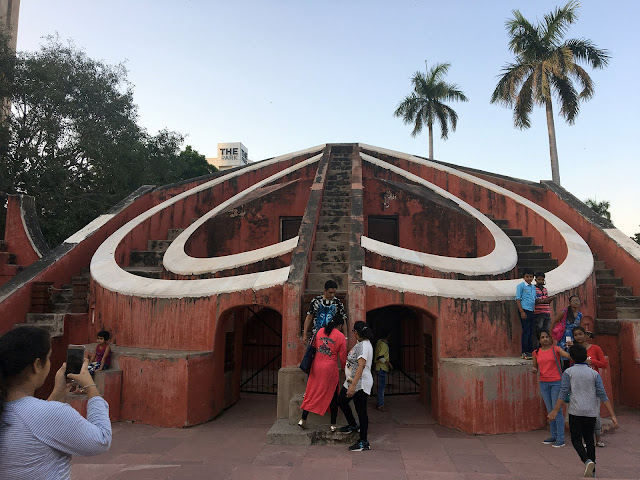Maharaj Sawai Jai Singh II became
a Rajput ruler in 1699, at the tender age of 11. He proceeded to become a rock
star of a ruler; in addition to numerous wars and conquests, he also designed
and constructed architectural marvels such as the beautiful city of Jaipur and
Amber Fort. He also had a unique lifelong interest in the science of
astronomical observation and calculation, and in 1724 he began the design and
construction of large-scale astronomical observation instruments known as the
Jantar Mantar. The observatories were constructed at five different sites:
Jaipur, Delhi, Varanasi, Ujjain, and Mathura. These sites are still standing,
and in recent weeks I visited the Jantar Mantar of Jaipur and Delhi.
A key theme of my Fulbright
research is the role of geometrical pattern in Indian ritual and divinatory
drawing/painting. Upon discovering the strange, otherworldly Jantar Mantar, I
was captivated by not only the science behind their construction,
but also the extreme beauty of their precise geometrical symmetry and abstract minimal
form. In their scale and design, the forms feel weirdly modern - but also
timeless. I was reminded at once of Stonehenge and of Richard Serra’s large
scale steel arcs and planes. The strangeness of the forms comes in part from
their combination of architecture and mathematical functionality. Human-scaled
steps and arched windows create points of access for the body, but the forms
are otherwise functional in design, and feel a bit like alien structures or
great crystalline geological accretions. Circular arcs, triangles, cylinders,
and precise graduated markings echo the mathematical precision of their purpose
on a just-beyond-human scale. The instruments are notably devoid of aesthetic
adornment so characteristic of the time, and it’s especially strange to
encounter them at the Jaipur site, where in every direction heavily ornamented
structures dominate the cityscape.
Often the most compelling
artistic objects arise from an urgent desire to make visible the invisible.
The strange forms of the Jantar Mantar were born of Jai Singh’s profound
curiosity about the workings of phenomena just beyond his visual reach. Their design reflects a human wish to draw the celestial realm closer, to
somehow trap it within range of our sensory apprehension. Today scientists
navigate this realm with the confidence and certainty of satellite imaging and
far-reaching technology; Jai Singh’s creations live much closer to the realm of
human sensory perception, and express more openly a navigation of the unknown.
Therefore, though constructed as instruments of science, they also invite
contemplation as art.
You can learn more about
Jantar Mantar at this fantastic site. They even have downloads for building
your own paper models!
JANTAR MANTAR, DELHI
 |
    
JANTAR MANTAR, JAIPUR
|







No comments:
Post a Comment